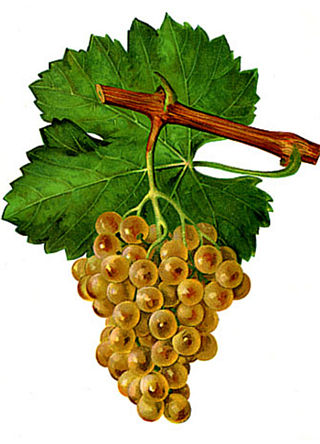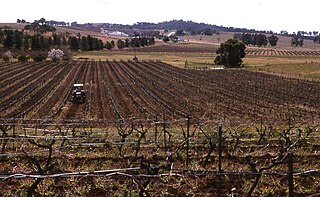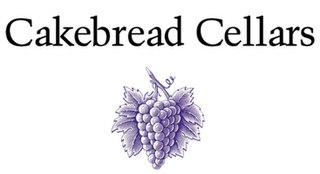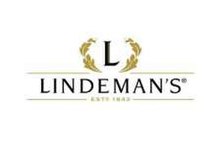
Chardonnay is a green-skinned grape variety used in the production of white wine. The variety originated in the Burgundy wine region of eastern France, but is now grown wherever wine is produced, from England to New Zealand. For new and developing wine regions, growing Chardonnay is seen as a 'rite of passage' and an easy entry into the international wine market.

Sémillon is a golden-skinned grape used to make dry and sweet white wines, mostly in France and Australia. Its thin skin and susceptibility to botrytis make it dominate the sweet wine region Sauternes AOC and Barsac AOC.

Penfolds is an Australian wine producer that was founded in Adelaide in 1844 by Christopher Rawson Penfold, an English physician who emigrated to Australia, and his wife Mary Penfold. It is one of Australia's oldest wineries, and is currently part of Treasury Wine Estates.

Pokolbin is a rural locality in the Hunter Region of New South Wales Australia. It is part of the Singleton Council local government area and the city of Cessnock. The area is the centre of the Lower Hunter Valley wine region. Pokolbin lies within the Hunter Valley Important Bird Area.

Rosemount, previously Rosemount Estate Wines, is an Australian winery based in the Hunter Valley and South Australia, owned by Treasury Wine Estates. At the turn of the 21st century, Rosemount was the second-best selling Australian wine brand in the United States.
Tahbilk Winery is a historic Australian winery with National Trust certification. It is located 120 km (75 mi) north of Melbourne between the townships of Seymour and Nagambie in the Nagambie Lakes a sub region of Goulburn Valley Wine Region. It was established in 1860, and is the oldest family-owned winery and vineyard in Victoria. The winery is part of Australia's First Families of Wine, a prominent Australian wine alliance.

New South Wales wine is Australian wine produced in New South Wales, Australia. New South Wales is Australia's most populous state and its wine consumption far outpaces the region's wine production. The Hunter Valley, located 130 km (81 mi) north of Sydney, is the most well-known wine region but the majority of the state's production takes place in the Big Rivers zone-Perricoota, Riverina and along the Darling and Murray Rivers. The wines produced from the Big Rivers zone are largely used in box wine and mass-produced wine brands such as Yellow Tail. A large variety of grapes are grown in New South Wales, including Cabernet Sauvignon, Chardonnay, Shiraz and Sémillon.

Thomas Hardy was a winemaker in the McLaren Vale, South Australia. He has been called the "Father of the South Australian Wine Industry".
Tintara is an Australian winery located in McLaren Vale, South Australia within the McLaren Vale wine region. The winery was established in 1861 and incorporated in the 1862 as the Tintara Vineyard Company by Alexander Kelly, a medical physician and winemaker who wrote the early Australian winemaking and viticultural text Winegrowing in Australia and The Vine in Australia. Several prominent figures in the early history of South Australia and McLaren Vale were initial investors in the winery including the founder of the University of Adelaide, Walter Watson Hughes, landowner Samuel Davenport and politician Thomas Elder. Today the winery holds the distinction of producing the oldest surviving bottle of Australian wine—an 1867 Tintara Vineyard claret. The Tintara wine earned the distinction when the previous record holder, an 1864 bottle of Pewsey Vale Cabernet Sauvignon, was accidentally broken by an office cleaner at Christie's auction house.
Giaconda is an Australian winery in Beechworth, Victoria.

The Hunter Valley is one of Australia's wine regions. Located in the state of New South Wales and first cultivated in the early 19th century, it was one of the first Australian wine regions. As well as Hunter Valley Sémillon, the region produces wine from a variety of grapes including Shiraz, Chardonnay, Cabernet Sauvignon and Verdelho.
Leeuwin Estate is an Australian winery and restaurant based in the Margaret River wine region of Western Australia.

Benjamin Cane is an Australian winemaker who currently owns Duke's Vineyard in the Great Southern region of Western Australia.

Cakebread Cellars is a Napa Valley winery known for its Chardonnay and Sauvignon Blanc wines, which are internationally distributed. Founded in 1973 by Jack and Dolores Cakebread in Rutherford, California, the winery produces approximately 200,000 cases of wine per year.

Orange is a wine region and Australian Geographical Indication in the Central Ranges zone in the Australian state of New South Wales. It is named for the town of Orange and defined as the contiguous area that is above 600 metres (2,000 ft) elevation within the City of Orange, Cabonne Shire and Blayney Shire.
The Tolley family were important winemakers, merchants and distillers in South Australia. Members of the family formed three businesses: A. E. & F. Tolley, wine merchants of Leigh Street, Adelaide, Tolley Scott & Tolley, distillers of Stepney and Nuriootpa, better known by the initials "T.S.T.", and Douglas A. Tolley Pty, Ltd., winemakers of Hope Valley.
Peter Bond Burgoyne was an English wine merchant, founder and head of P. B. Burgoyne and Co., Ltd., and Australian Wine Importers, Ltd. He has been called "the father of the Australian wine industry in Great Britain".
Philip Shaw is an Australian winemaker.
Theodor Gustav Hermann Büring, commonly anglicized to "Herman" and "Buring", was an Australian wine merchant and vigneron.
Hermann Paul Leopold Büring, generally known as Leo Buring, was an Australian wine maker and merchant. He is commemorated at Roseworthy Agricultural College in the Leo Buring gold medal for dux of the oenology course.











